Jinshan Temple (金山寺), perched at an altitude of 43.7 meters atop Jinshan Hill in the northwest of Zhenjiang City, is renowned as one of China’s four great temples alongside Putuo Temple, Wenshu Temple, and Daming Temple. Initially situated at the heart of the Yangtze River alongside Jinshan, the temple eventually became connected to the southern land when the river shifted northward during the late Qing Guangxu period.
Its origins trace back to the era of Emperor Yuan of the Eastern Jin Dynasty (around 320 AD). During the fourth year of the Tianjian era in the Liang Dynasty (505 AD), Emperor Wu of Liang presided over a water and land dharma assembly here, marking Jinshan Temple as the birthplace of these rituals. Renamed multiple times throughout history, it was known as “Zexin Temple” during the Tang Dynasty, “Longyou Temple” in the reign of Emperor Zhenzong in the Northern Song Dynasty, and “Jiangtian Zen Temple” in the Qing Dynasty under Emperor Kangxi.
Breaking away from the traditional north-facing layout, Jinshan Temple embraces the natural contours of the mountain. From a distance, the temple dominates the view, concealing the mountain itself. What captivates visitors most about Jinshan Temple are the numerous folk tales associated with it, notably the tale of the White Snake Lady flooding Jinshan.
Table of Contents
- Location and Transportation
- Map of Jinshan Temple
- Highlights of Jinshan Temple
- Vlog about Jinshan Temple
- A Brief History of Jinshan Temple
- Attractions near Jinshan Temple
Basic Information
| Estimated Length of Tour | 2 hours |
| Ticket Price | 50 RMB |
| Opening Hours | 8.00 – 17.00; Last admission: 16.30 |
| Telephone Number | 0086-0511-85512992 0086-0511-85512780 |
Location and Transportation
Jinshan Temple is located at 62 Jinshan Road, Runzhou District, Zhenjiang City, Jiangsu Province, China. Situated just 3 kilometers from the city center, it is easily accessible and holds a prominent position in the region.
To get there, tourists can take bus 17, 40, 49, 102, 115, 133, or 216, and get off at Jinshan Park Stop (金山公园站).
Map of Jinshan Temple
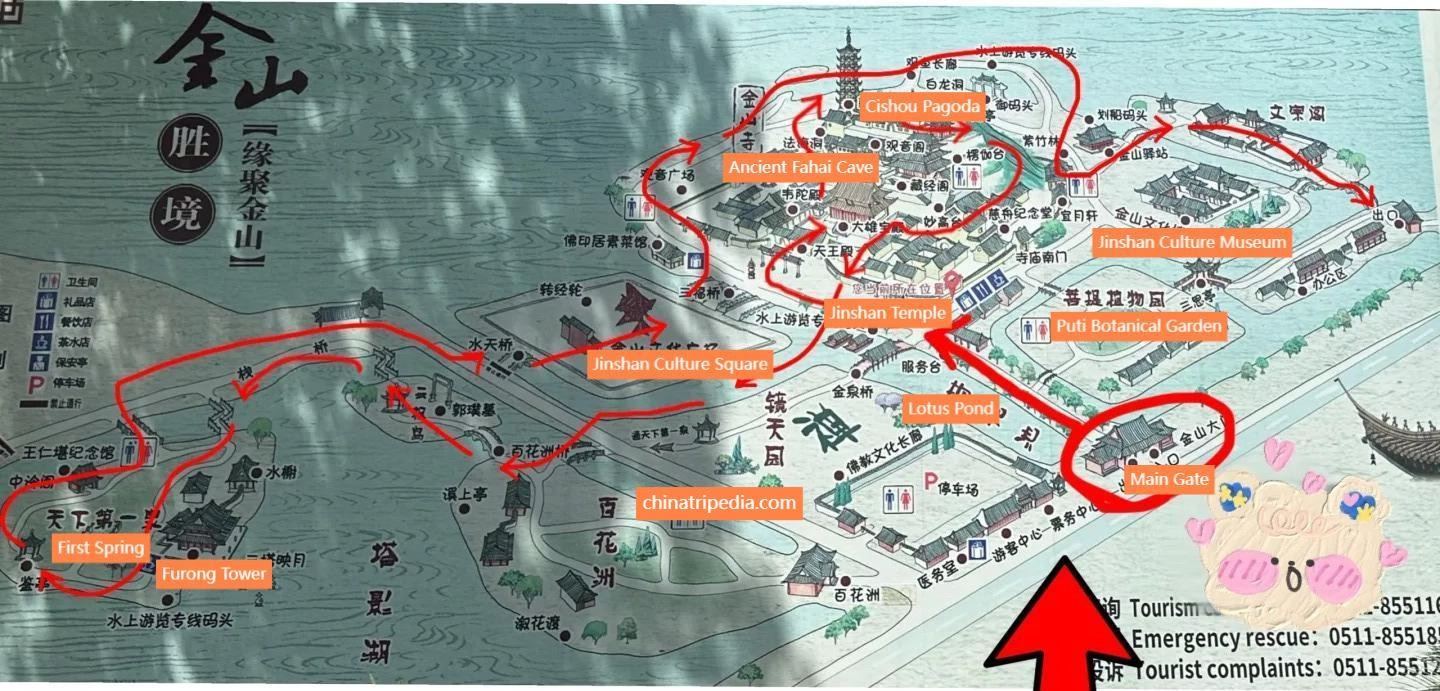
Highlights of Jinshan Temple
Cishou Pagoda
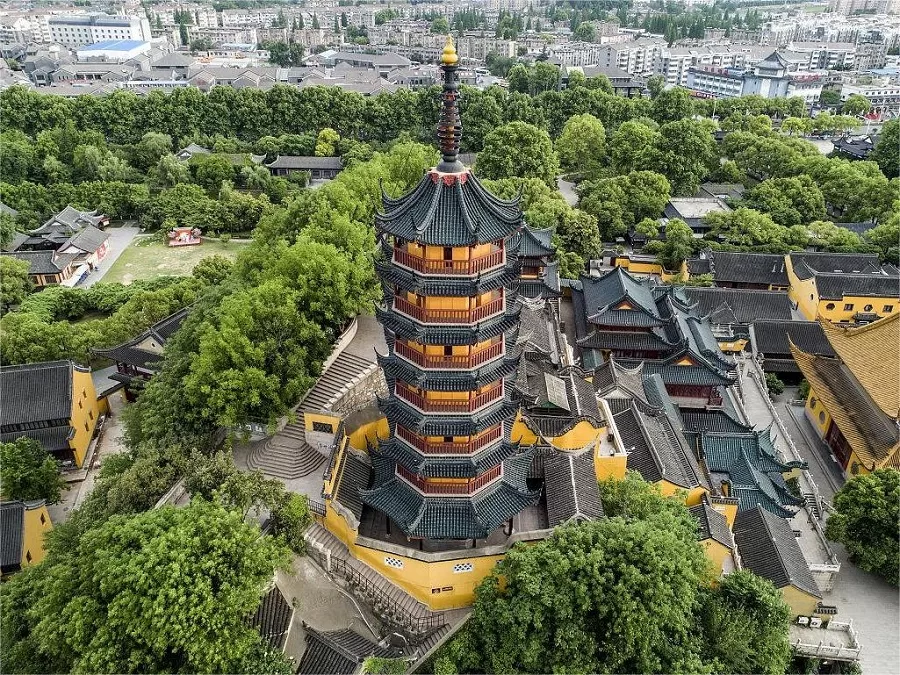
Rising approximately 36 meters high, the Cishou Pagoda is a brick-and-wood structure consisting of seven tiers and eight sides. It stands tall atop a series of pavilions and halls, serving as the symbol of Jinshan. The original Cishou Pagoda dates back to the Southern Qi and Liang Dynasties, initially comprising two opposing towers that later collapsed. During the reign of Emperor Zhezong of the Song Dynasty (1098-1100 AD), reconstruction occurred, resulting in the current octagonal seven-tiered pagoda. Subsequently renovated by Ming Dynasty monk Liaoming in the third year of the Longqing era (1569), the present-day Cishou Pagoda was reconstructed in the 26th year of the Guangxu era (1900).
Furong Tower
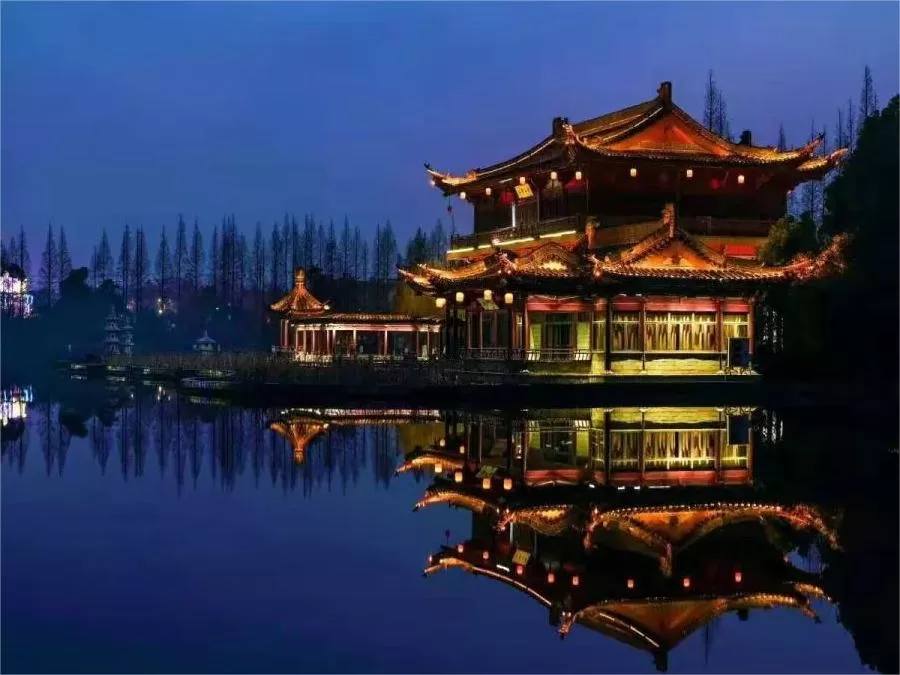
Located adjacent to the “Number One Spring Under Heaven” on Jinshan, the Furong Tower was originally constructed on Yuexiu Mountain within the ancient Zhenjiang city. Initially built by Wang Gong, the local governor of Eastern Jin, its remnants persisted into the Tang Dynasty. In 1992, to harness Zhenjiang’s scenic and historical value for tourism, efforts were made to reconstruct this renowned historical site. The architectural ensemble comprises the Furong Tower, Bingxin Pavilion, Juyue Pavilion, and three stone pagodas in the lake, interconnected with winding corridors, creating a picturesque setting. The Furong Tower itself is a two-story, 19-meter-tall, double-eaved, ancient-style building occupying an area of over 1000 square meters.
Ancient Fuhai Cave
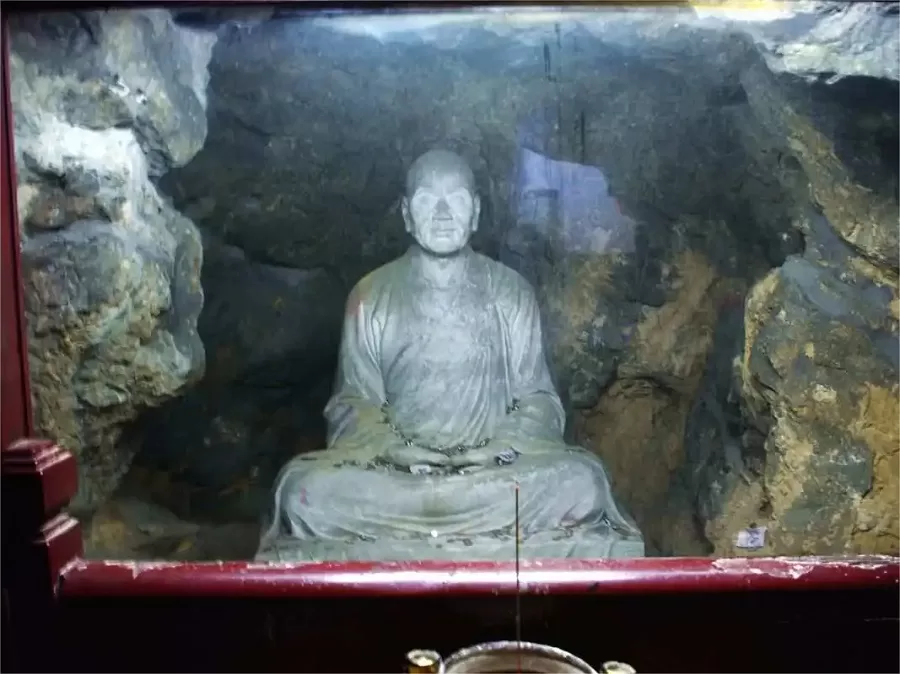
Also known as the Peigong Cave, the Ancient Fahai Cave is situated on a cliff below the western side of the Cishou Pagoda. According to legend, this cave served as the dwelling place for Fahai, the founding monk of Jinshan Temple. Inside the cave, there is a statue of Fahai, and a horizontal plaque above the entrance reads “Ancient Fahai Cave.” Legend has it that Fahai was the son of Pei Xiu, a prime minister during the Tang Dynasty. Pei Xiu, a devout Buddhist, sent his son to become a monk, naming him Fahai. Respecting his father’s wishes, Fahai first studied and practiced Zen on Mount Lu in Jiangxi. Later, he traveled down the Yangtze River, arriving at Jinshan in Zhenjiang. Fahai dedicated himself to rigorous meditation in the cave and also initiated farming, laying the foundation for the establishment of Jinshan Temple.
Cultural Relics and Artifacts
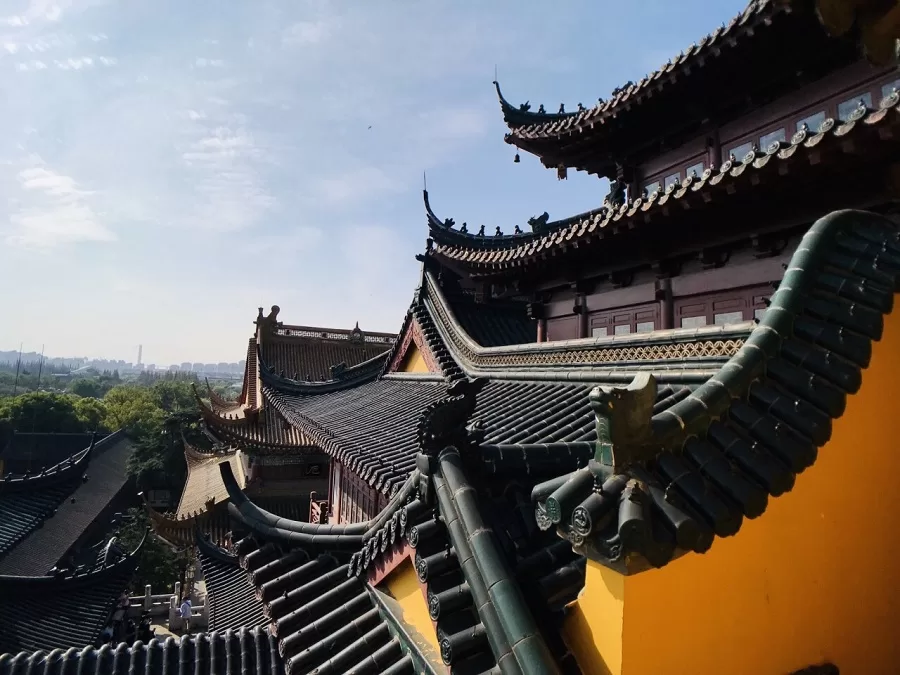
Within the premises beneath the Cishou Pagoda, a house displays a collection of precious historical artifacts of Jinshan Temple, including the Jade Belt of Su Dongpo, Zhou Ding (a bronze vessel), the Jinshan Painting, and a bronze drum, collectively known as the “Four Treasures of Jinshan.” Zhou Ding dates back to the Western Zhou era during the reign of King Xuan. Crafted over 2,700 years ago, it was cast as a reward for General Sui Qiji after the successful northern expedition. The Jinshan Painting is a masterpiece by the renowned Ming Dynasty painter Wen Zhengming, depicting the vast expanse of the Yangtze River, with gentle ripples and the Jinshan hill seemingly floating above the waves. The bronze drum, measuring eight inches in height and one foot five inches in diameter, weighing twenty-three pounds and eight ounces, is believed to be invented by Zhuge Liang. It served as a cooking utensil during marches and a battle drum during combat. These artifacts not only hold historical significance but also contribute to the rich cultural heritage of Jinshan Temple.
Vlog about Jinshan Temple
A Brief History of Jinshan Temple
Jinshan Temple was originally built during the Eastern Jin Dynasty, though its exact founding date remains uncertain. Initially known as “Zexin Temple,” it was constructed on an isolated island in the Yangtze River. In 505 AD, Emperor Wu of Liang hosted the first recorded Buddhist Water and Land Ritual here, a practice that later became a major Buddhist tradition in China.
During the Tang Dynasty, the temple had fallen into disrepair. A monk named Fahai vowed to restore it and miraculously discovered gold while digging at the riverbank. The local governor reported this to Emperor Xuanzong, who decreed that the gold be used for the temple’s restoration and renamed it Jinshan Temple (“Golden Mountain Temple”).
In the Song Dynasty, Emperor Zhenzong dreamed of visiting the temple and later personally inscribed “Longyou Mountain” on its gate. The temple was later renamed “Longyou Chan Temple,” but after suffering fire damage, it was restored with grander structures. By the late Song period, Jinshan Temple was renowned for its spectacular Water and Land Rituals.
During the Qing Dynasty, Emperor Kangxi visited the temple and renamed it Jiangtian Temple, personally inscribing its plaque. It became one of the four major Zen monasteries along the Yangtze River. However, it suffered severe damage during the Taiping Rebellion and was almost entirely rebuilt in 1869 through donations from salt merchants.
In modern times, the temple faced further destruction in a 1948 fire and suffered neglect during the Cultural Revolution. It was later restored and reopened in the 1980s, once again becoming an active Buddhist site.





0 Comment